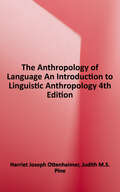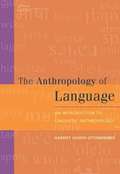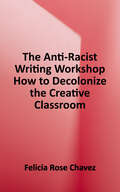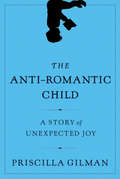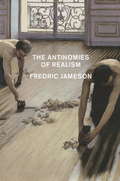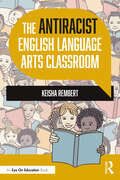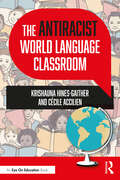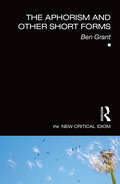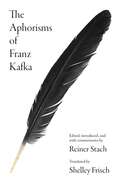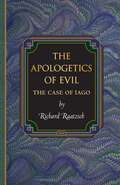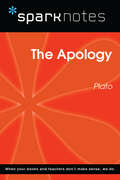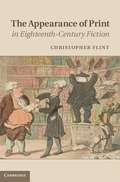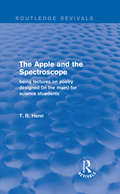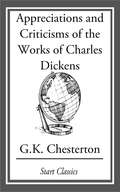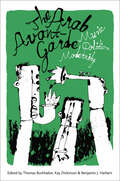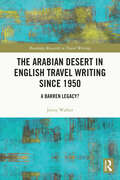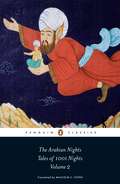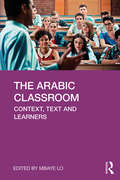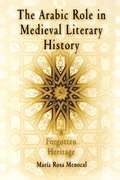- Table View
- List View
The Anthropology of Language: An Introduction to Linguistic Anthropology
by Harriet Joseph Ottenheimer Judith M. S. PineLearn the methodology, skills, techniques, tools, and applications of Linguistic Anthropology with The Anthropology of Language: An Introduction to Linguistic Anthropology. This highly readable introductory text emphasizes the kinds of intriguing questions that anthropologists ask about language. The fourth edition brings together the key areas of linguistic anthropology, addressing issues of power, race, gender and class throughout. "In the Field" vignettes draw you into the chapter material and are culled from authors Ottenheimer and Pine's own experiences, among others. Other features--"Doing Linguistic Anthropology" and "Cross-Language iscommunication"--describe some of the real-life applications of concepts discussed in the text, helping you cement your understanding of the concepts and their relevance.
The Anthropology of Language: An Introduction to Linguistic Anthropology (Second Edition)
by Harriet OttenheimerOttenheimer's authoritative yet approachable introduction to the field's methodology, skills, techniques, tools, and applications emphasizes the kinds of questions that anthropologists ask about language and the kinds of questions that intrigue students. The text brings together the key areas of linguistic anthropology, addressing issues of power, race, gender, and class throughout. Further stressing the everyday relevance of the text material, Ottenheimer includes "In the Field" vignettes that draw you in to the chapter material via stories culled from her own and others' experiences, as well as "Doing Linguistic Anthropology" and "Cross-Language Miscommunication" features that describe real-life applications of text concepts.
The Anti-Journalist: Karl Kraus and Jewish Self-Fashioning in Fin-de-Siècle Europe (Studies In German-jewish Cultural Histor Ser.)
by Paul ReitterIn turn-of-the-century Vienna, Karl Kraus created a bold new style of media criticism, penning incisive satires that elicited both admiration and outrage. Kraus’s spectacularly hostile critiques often focused on his fellow Jewish journalists, which brought him a reputation as the quintessential self-hating Jew. The Anti-Journalist overturns this view with unprecedented force and sophistication, showing how Kraus’s criticisms form the center of a radical model of German-Jewish self-fashioning, and how that model developed in concert with Kraus’s modernist journalistic style.Paul Reitter’s study of Kraus’s writings situates them in the context of fin-de-siècle German-Jewish intellectual society. He argues that rather than stemming from anti-Semitism, Kraus’s attacks constituted an innovative critique of mainstream German-Jewish strategies for assimilation. Marshalling three of the most daring German-Jewish authors—Kafka, Scholem, and Benjamin—Reitter explains their admiration for Kraus’s project and demonstrates his influence on their own notions of cultural authenticity. The Anti-Journalist is at once a new interpretation of a fascinating modernist oeuvre and a heady exploration of an important stage in the history of German-Jewish thinking about identity.
The Anti-Racist Writing Workshop: How to Decolonize the Creative Classroom
by Felicia Rose ChavezThis easy-to-use guide explains how to recruit, nourish, and fortify writers of color through innovative reading, writing, workshop, critique, and assessment strategies. A captivating mix of memoir and progressive teaching strategies, The Anti-Racist Writing Workshop: How to Decolonize the Creative Classroom demonstrates how to be culturally attuned, twenty-first-century educators. The Anti-Racist Writing Workshop is a call to create healthy, sustainable, and empowering classroom communities. Award-winning educator Felicia Rose Chavez exposes the invisible politics of power and privilege that have silenced writers of color for far too long. It’s more urgent than ever that we consciously work against traditions of dominance in the classroom, but what specific actions can we take to achieve authentically inclusive communities? Together, we will address how to: - Deconstruct our biases to achieve a cultural shift in perspective. - Design a democratic teaching model to create safe spaces for creative concentration. - Recruit, nourish, and fortify students of color to best empower them to exercise voice. - Embolden our students to self-advocate as responsible citizens in a globalized community. Finally, a teaching model that protects and platforms students of color, because every writer deserves access to a public voice. For anyone looking to liberate their thinking from “the way it’s always been done,” The Anti-Racist Writing Workshop is a clear, compelling guidebook on a necessary step forward.
The Anti-Romantic Child: A Story of Unexpected Joy
by Priscilla Gilman“A beautifully sinuous and intensely literary celebration of the exceptional, unconventional child.” —Publishers Weekly, starred reviewPriscilla Gilman, a teacher of romantic poetry who embraced Wordsworth’s vision of childhood’s spontaneous wonder, eagerly anticipated the birth of her first child, certain that he would come trailing clouds of glory. But as Benjamin grew, his remarkable precocity was associated with a developmental disorder that would dramatically alter the course of Priscilla’s dreams.In The Anti-Romantic Child, a memoir full of lyricism and light, Gilman explores our hopes and expectations for our children, our families, and ourselves—and the ways in which experience may lead us to re-imagine them. Using literature as a touchstone, Gilman reveals her journey through crisis to joy, illuminating the flourishing of life that occurs when we embrace the unexpected. The Anti-Romantic Child is a profoundly moving and compellingly universal book about family, parenthood, and love.“Haunting and lyrical.” —Marie Brenner, author of Apples and Oranges“Rapturously beautiful and deeply moving, profound and marvelous” —Andrew Solomon, author of The Noonday Demon and Far From the Tree“A lovely, thoughtful memoir.” —The Boston Globe“A striking celebration of the bond between a mother and son.” —Kirkus Reviews“Gilman is at once lyrical and deeply analytical as she explores the complexities of parenthood and the need to embrace the unforeseen.” —Booklist, starred review“A book every parent should read.” —Kathryn Erskine, National Book award–winning author of Mockingbird “A very moving personal story.” —Tina Brown, Newsweek“Smart, soulful, and involving.” —Nick Hornby, The Believer
The Antinomies Of Realism
by Fredric JamesonThe Antinomies of Realism is a history ofthe nineteenth-century realist novel and its legacy told without a glimmer of nostalgia for artistic achievements that the movement of history makes it impossible to recreate. The works of Zola, Tolstoy, Pérez Galdós, and George Eliot are in the most profound sense inimitable, yet continue to dominate the novel form to this day. Novels to emerge since struggle to reconcile the social conditions of their own creation with the history of this mode of writing: the so-called modernist novel is one attempted solution to this conflict, as is the ever-more impoverished variety of commercial narratives - what today's book reviewers dub "serious novels," which are an attempt at the impossible endeavor to roll back the past. Fredric Jameson examines the most influential theories of artistic and literary realism, approaching the subject himself in terms of the social and historical preconditions for realism's emergence. The realist novel combined an attention to the body and its states of feeling with a focus on the quest for individual realization within the confines of history. In contemporary writing, other forms of representation - for which the term "postmodern" is too glib - have become visible: for example, in the historical fiction of Hilary Mantel or the stylistic plurality of David Mitchell's novels. Contemporary fiction is shown to be conducting startling experiments in the representation of new realities of a global social totality, modern technological warfare, and historical developments that, although they saturate every corner of our lives, only become apparent on rare occasions and by way of the strangest formal and artistic devices.In a coda, Jameson explains how "realistic" narratives survived the end of classical realism. In effect, he provides an argument for the serious study of popular fiction and mass culture that transcends lazy journalism and the easy platitudes of recent cultural studies.From the Hardcover edition.
The Antiracist English Language Arts Classroom
by Keisha RembertHow can you incorporate antiracist practices into specific subject areas? This practical guide answers that question and provides a road map for introducing antiracism into the English language arts (ELA) classroom with teacher-friendly tools and strategies. Drawing on foundational and cutting-edge knowledge of antiracism, expert Keisha Rembert responds to the following questions: What does antiracism look like in the English language arts classroom, given the unique responsibilities of the ELA educator; why is it vital to implement antiracist practices that are relevant to your classroom and school; and how can you enact antiracist pedagogies that foster critical engagement and stimulate a culture of antiracism? Aligned with National Council of Teachers of English standards, this accessible resource is replete with hands-on antiracist activities, teacher insights and interviews, questions to spark reflection and action and lesson plans and is essential reading for all ELA teachers. From building an antiracist foundation to evaluating the effect of antiracist practice on students and reflecting on your own lived experience, this book is a truly comprehensive guide for educators who want to empower all students. Rembert demonstrates how to find motivation in progress and joy in the process, pushing past confusion and discomfort in a continued effort to create an equitable, inclusive and antiracist ELA classroom.
The Antiracist World Language Classroom
by Cécile Accilien Krishauna Hines-GaitherHow can you incorporate antiracist practices into specific subject areas? This essential book finally answers that question and offers a clear roadmap for introducing antiracism into the world language classroom. Drawing on foundational and cutting-edge knowledge of antiracism, authors Hines-Gaither and Accilien address the following questions: what does antiracism look like in the world language classroom; why is it vital to implement antiracist practices relevant to your classroom or school; and how can you enact antiracist pedagogies and practices that enrich and benefit your classroom or school? Aligned with the American Council on the Teaching of Foreign Languages standards, the book is filled with hands-on antiracist activities, strategies, and lesson plans. The book covers all necessary topics, including designing antiracist units of study, teaching across proficiency levels, advocacy and collaboration in the community, and how to facilitate self- reflection to become an active antiracist educator. The tools, prompts, and resources in this book are essential for any world language teacher, department chair, or school leader.
The Aphorism and Other Short Forms (The New Critical Idiom)
by Ben GrantThe aphorism captures a huge amount of truth, meaning or wit in a very short statement. It has been used and studied from classical times to contemporary theory and takes on a new relevance when we look at today’s communication media such as text messages and twitter. This concise guide offers an overview of: The history of the aphorism to the present day Its relation to other short forms, including the fragment, the proverb, the maxim, the haiku, the epigram and the quotation The use of the aphorism by authors such as Heraclitus, Bacon, La Rochefoucauld, Chuang Tzu, Blake, Schlegel, Emerson, Nietzsche, Wilde, Woolf and Barthes The interdisciplinary nature of the aphorism, bringing together science, philosophy, literature and religion Exploring all the key aspects of the form, Ben Grant guides readers through this large and lively area in a wide-ranging and critically informed study of the aphorism.
The Aphorisms of Franz Kafka
by Franz KafkaA splendid new translation of an extraordinary work of modern literature—featuring facing-page commentary by Kafka’s acclaimed biographerIn 1917 and 1918, Franz Kafka wrote a set of more than 100 aphorisms, known as the Zürau aphorisms, after the Bohemian village in which he composed them. Among the most mysterious of Kafka’s writings, they explore philosophical questions about truth, good and evil, and the spiritual and sensory world. This is the first annotated, bilingual volume of these extraordinary writings, which provide great insight into Kafka’s mind. Edited, introduced, and with commentaries by preeminent Kafka biographer and authority Reiner Stach, and freshly translated by Shelley Frisch, this beautiful volume presents each aphorism on its own page in English and the original German, with accessible and enlightening notes on facing pages.The most complex of Kafka’s writings, the aphorisms merge literary and analytical thinking and are radical in their ideas, original in their images and metaphors, and exceptionally condensed in their language. Offering up Kafka’s characteristically unsettling charms, the aphorisms at times put readers in unfamiliar, even inhospitable territory, which can then turn luminous: “I have never been in this place before: breathing works differently, and a star shines next to the sun, more dazzlingly still.”Above all, this volume reveals that these multifaceted gems aren’t far removed from Kafka’s novels and stories but are instead situated squarely within his cosmos—arguably at its very core. Long neglected by Kafka readers and scholars, his aphorisms have finally been given their full due here.
The Apologetics of Evil: The Case of Iago (Princeton Monographs in Philosophy #26)
by Richard RaatzschThis book is a concise philosophical meditation on Iago and the nature of evil, through the exploration of the enduring puzzle found in Shakespeare's Othello. What drives Iago to orchestrate Othello's downfall? Instead of treating Iago's lack of motive as the play's greatest weakness, The Apologetics of Evil shows how this absence of motive is the play's greatest strength. Richard Raatzsch determines that Iago does not seek a particular end or revenge for a discrete wrong; instead, Iago is governed by a passion for intriguing in itself. Raatzsch explains that this passion is a pathological version of ordinary human behavior and that Iago lacks the ability to acknowledge others; what matters most to him is the difference between himself and the rest of the world. The book opens with a portrait of Iago, and considers the nature and moral significance of the evil that he represents. Raatzsch addresses the boundaries dividing normality and pathology, conceptualizing evil as a pathological form of the good or ordinary. Seen this way, evil is conceptually dependent on the ordinary, and Iago, as a form of moral monster, is a kind of nonbeing. Therefore, his actions might be understood and defended, even if they cannot be justified. In a brief epilogue, Raatzsch argues that literature's presentation of what is monstrous or virtuous can constitute an understanding of these concepts, not merely illustrate them.
The Apology (SparkNotes Philosophy Guide)
by SparkNotesThe Apology (SparkNotes Philosophy Guide) Making the reading experience fun! SparkNotes Philosophy Guides are one-stop guides to the great works of philosophy–masterpieces that stand at the foundations of Western thought. Inside each Philosophy Guide you&’ll find insightful overviews of great philosophical works of the Western world.
The Appearance of Print in Eighteenth-Century Fiction
by Christopher FlintEighteenth-century fiction holds an unusual place in the history of modern print culture. The novel gained prominence largely because of advances in publishing, but, as a popular genre, it also helped shape those very developments. Authors in the period manipulated the appearance of the page and print technology more deliberately than has been supposed, prompting new forms of reception among readers. Christopher Flint's book explores works by both obscure 'scribblers' and canonical figures, such as Swift, Haywood, Defoe, Richardson, Sterne and Austen, that interrogated the complex interactions between the book's material aspects and its producers and consumers. Flint links historical shifts in how authors addressed their profession to how books were manufactured and how readers consumed texts. He argues that writers exploited typographic media to augment other crucial developments in prose fiction, from formal realism and free indirect discourse to accounts of how 'the novel' defined itself as a genre.
The Apple and the Spectroscope: Being Lectures on Poetry Designed (in the main) for Science Students (Routledge Revivals)
by T R HennFirst published in 1951, this book is based on a course of lectures on poetry and prose given at Cambridge University during the long vacations of 1946-1950. A request for lectures of this kind came originally from a group of science students and the response was such that a course of this nature ran yearly. The purpose was to provide students from disciplines other than the humanities with the opportunity to feed their interest in English poetry and literature.
The Appreciations and Criticisms of t
by G. K. ChestertonBorn in London, Chesterton was educated at St. Paul's, but never went to college. He went to art school. In 1900, he was asked to contribute a few magazine articles on art criticism, and went on to become one of the most prolific writers of all time. He wrote a hundred books, contributions to 200 more, hundreds of poems, including the epic Ballad of the White Horse, five plays, five novels, and some two hundred short stories, including a popular series featuring the priest-detective, Father Brown. In spite of his literary accomplishments, he considered himself primarily a journalist. He wrote over 4000 newspaper essays, including 30 years worth of weekly columns for the Illustrated London News, and 13 years of weekly columns for the Daily News. He also edited his own newspaper, G.K.'s Weekly. (To put it into perspective, four thousand essays is the equivalent of writing an essay a day, every day, for 11 years. If you're not impressed, try it some time. But they have to be good essays, all of them, as funny as they are serious, and as readable and rewarding a century after you've written them.) Chesterton was equally at ease with literary and social criticism, history, politics, economics, philosophy, and theology. His style is unmistakable, always marked by humility, consistency, paradox, wit, and wonder. His writing remains as timely and as timeless today as when it first appeared, even though much of it was published in throw away paper. This man who composed such profound and perfect lines as "The Christian ideal has not been tried and found wanting; it has been found difficult and left untried," stood 6'4" and weighed about 300 pounds, usually had a cigar in his mouth, and walked around wearing a cape and a crumpled hat, tiny glasses pinched to the end of his nose, swordstick in hand, laughter blowing through his moustache. And usually had no idea where or when his next appointment was. He did much of his writing in train stations, since he usually missed the train he was supposed to catch. In one famous anecdote, he wired his wife, saying, "Am at Market Harborough. Where ought I to be?" His faithful wife, Frances, attended to all the details of his life, since he continually proved he had no way of doing it himself. She was later assisted by a secretary, Dorothy Collins, who became the couple's surrogate daughter, and went on to become the writer's literary executrix, continuing to make his work available after his death. This absent-minded, overgrown elf of a man, who laughed at his own jokes and amused children at birthday parties by catching buns in his mouth, was the man who wrote a book called The Everlasting Man, which led a young atheist named C.S. Lewis to become a Christian. This was the man who wrote a novel called The Napoleon of Notting Hill, which inspired Michael Collins to lead a movement for Irish Independence. This was the man who wrote an essay in the Illustrated London News that inspired Mahatma Gandhi to lead a movement to end British colonial rule in India. This was a man who, when commissioned to write a book on St. Thomas Aquinas (aptly titled Saint Thomas Aquinas), had his secretary check out a stack of books on St.
The Arab Avant-Garde: Music, Politics, Modernity (Music Culture)
by Thomas Burkhalter, Kay Dickinson, and Benjamin J. HarbertThe first in-depth study of diverse and radical innovation in Arab music From jazz trumpeters drawing on the noises of warfare in Beirut to female heavy metallers in Alexandria, the Arab culture offers a wealth of exciting, challenging, and diverse musics. The essays in this collection investigate the plethora of compositional and improvisational techniques, performance styles, political motivations, professional trainings, and inter-continental collaborations that claim the mantle of "innovation" within Arab and Arab diaspora music. While most books on Middle Eastern music-making focus on notions of tradition and regionally specific genres, The Arab Avant Garde presents a radically hybrid and globally dialectic set of practices. Engaging the "avant-garde"—a term with Eurocentric resonances—this anthology disturbs that presumed exclusivity, drawing on and challenging a growing body of literature about alternative modernities. Chapters delve into genres and modes as diverse as jazz, musical theatre, improvisation, hip hop, and heavy metal as performed in countries like Iraq, Egypt, Lebanon, Syria, Palestine, and the United States. Focusing on multiple ways in which the "Arab avant-garde" becomes manifest, this anthology brings together international writers with eclectic disciplinary trainings—practicing musicians, area studies specialists, ethnomusicologists, and scholars of popular culture and media. Contributors include Sami W. Asmar, Michael Khoury, Saed Muhssin, Marina Peterson, Kamran Rastegar, Caroline Rooney, and Shayna Silverstein, as well as the editors.
The Arabesque from Kant to Comics (Routledge Advances in Art and Visual Studies)
by Cordula GreweThe Arabesque from Kant to Comics tracks the life and afterlife of the arabesque in its surprising transformation from an iconoclastic literary theory of early German Romanticism to aesthetic experimentation in both avant-garde art and popular culture. Its explosive growth in popularity was followed by an inevitable taming as arabesques became staples in book illustration, poetry publications, and even the decoration of printed scores. The subversive potential of the arabesque was preserved in one of its most surprising offspring, the comic strip: born at the moment when the cholera pandemic first swept through Europe, the comic translated the arabesque’s rank growth into unnerving lawlessness and sequences of contagious visual slapstick. Focusing roughly on the period between 1780 and 1880, this book illuminates the intersecting histories of avant-garde theories of writing, visual culture, and even the disciplinary origins of art history. In the process, it explores media history and intermediality, social networks and cultural transfer, as well as the rise of new and nontraditional art forms. This book will be of particular interest to scholars of art history, intellectual history, European art, aesthetics, book illustration, material culture, reproduction, comics, and German history.
The Arabian Desert in English Travel Writing Since 1950: A Barren Legacy? (Routledge Research in Travel Writing)
by Jenny WalkerBroadly this book is about the Arabian desert as the locus of exploration by a long tradition of British travellers that includes T.E. Lawrence and Wilfred Thesiger; more specifically, it is about those who, since 1950, have followed in their literary footsteps. In analysing modern works covering a land greater than the sum of its geographical parts, the discussion identifies outmoded tropes that continue to impinge upon the perception of the Middle East today while recognising that the laboured binaries of "East and West", "desert and sown", "noble and savage" have outrun their course. Where, however, only a barren legacy of latent Orientalism may have been expected, the author finds instead a rich seam of writing that exhibits diversity of purpose and insight contributing to contemporary discussions on travel and tourism, intercultural representation and environmental awareness. By addressing a lack of scholarly attention towards recent additions to the genre, this study illustrates for the benefit of students of travel literature, or indeed anyone interested in "Arabia", how desert writing, under the emerging configurations of globalisation, postcolonialism and ecocriticism, acts as a microcosm of the kinds of ethical and emotional dilemmas confronting today’s travel writers in the world’s most extreme regions.
The Arabian Nights: Volume 2 (The Arabian Nights #2)
by Robert Irwin Malcolm C. Lyons Ursula LyonsEvery night for three years the vengeful King Shahriyar sleeps with a different virgin, executing her next morning. To end this brutal pattern and to save her own life, the vizier's daughter, Shahrazad, begins to tell the king tales of adventure, love, riches and wonder - tales of mystical lands peopled with princes and hunchbacks, the Angel of Death and magical spirits, tales of the voyages of Sindbad, of Ali Baba's outwitting a band of forty thieves and of jinnis trapped in rings and in lamps. The sequence of stories will last 1,001 nights.
The Arabian Nights: Volume 3 (The Arabian Nights #3)
by Robert Irwin Malcolm C. Lyons Ursula LyonsEvery night for three years the vengeful King Shahriyar sleeps with a different virgin, executing her next morning. To end this brutal pattern and to save her own life, the vizier's daughter, Shahrazad, begins to tell the king tales of adventure, love, riches and wonder - tales of mystical lands peopled with princes and hunchbacks, the Angel of Death and magical spirits, tales of the voyages of Sindbad, of Ali Baba's outwitting a band of forty thieves and of jinnis trapped in rings and in lamps. The sequence of stories will last 1,001 nights.
The Arabic Classroom: Context, Text and Learners
by Mbaye LoThe Arabic Classroom is a multicontributor work for trainee and in-service teachers of Arabic as a foreign language. Collected here is recent scholarly work, and also critical writing from Arabic instructors, Arabists and language experts, to examine the status of the teaching and learning of Arabic in the modern classroom. The book stresses the inseparability of the parameters of contexts, texts and learners in the effective Arabic classroom and investigates their role in enhancing the experience of teaching and learning Arabic. The book also provides a regional perspective through global case studies and encourages Arabic experts to search for better models of instruction and best practices beyond the American experience.
The Arabic Print Revolution
by Ami AyalonIn a brief historic moment, printing presses, publishing ventures, a periodical press, circulation networks, and a mass readership came into being all at once in the Middle East, where none had previously existed, with ramifications in every sphere of the community's life. Among other outcomes, this significant change facilitated the cultural and literary movement known as the Arab 'nahda' ('awakening'). Ayalon's book offers both students and scholars a critical inquiry into the formative phase of that shift in Arab societies. This comprehensive analysis explores the advent of printing and publishing; the formation of mass readership; and the creation of distribution channels, the vital and often overlooked nexus linking the former two processes. It considers questions of cultural and religious tradition, social norms and relations, and concepts of education, offering a unique presentation of the emerging print culture in the Middle East.
The Arabic Role in Medieval Literary History
by Maria Rosa MenocalArabic culture was a central and shaping phenomenon in medieval Europe, yet its influence on medieval literature has been ignored or marginalized for the last two centuries. In this ground-breaking book, now returned to print with a new afterword by the author, María Rosa Menocal argues that major modifications of the medieval canon and its literary history are necessary.Menocal reviews the Arabic cultural presence in a variety of key settings, including the courts of William of Aquitaine and Frederick II, the universities in London, Paris, and Bologna, and Cluny under Peter the Venerable, and she examines how our perception of specific texts including the courtly love lyric and the works of Dante and Boccaccio would be altered by an acknowledgment of the Arabic cultural component.
The Arabs and the Holocaust: The Arab-Israeli War of Narratives
by Gilbert AchcarAn unprecedented and judicious examination of what the Holocaust means—and doesn't mean—in the Arab world, one of the most explosive subjects of our timeThere is no more inflammatory topic than the Arabs and the Holocaust—the phrase alone can occasion outrage. The terrain is dense with ugly claims and counterclaims: one side is charged with Holocaust denial, the other with exploiting a tragedy while denying the tragedies of others. In this pathbreaking book, political scientist Gilbert Achcar explores these conflicting narratives and considers their role in today's Middle East dispute. He analyzes the various Arab responses to Nazism, from the earliest intimations of the genocide, through the creation of Israel and the destruction of Palestine and up to our own time, critically assessing the political and historical context for these responses. Finally, he challenges distortions of the historical record, while making no concessions to anti-Semitism or Holocaust denial. Valid criticism of the other, Achcar insists, must go hand in hand with criticism of oneself.Drawing on previously unseen sources in multiple languages, Achcar offers a unique mapping of the Arab world, in the process defusing an international propaganda war that has become a major stumbling block in the path of Arab-Western understanding.
The Aran Islands
by John M. SyngeHere is the complete title: Collected Plays and Poems and The Aran Islands
